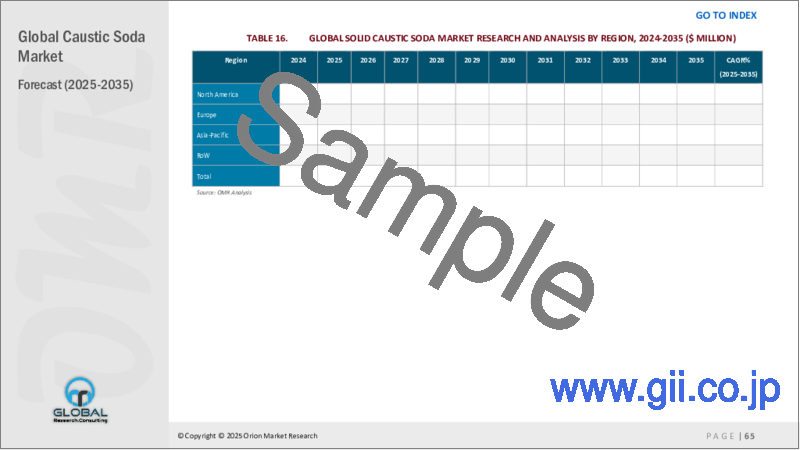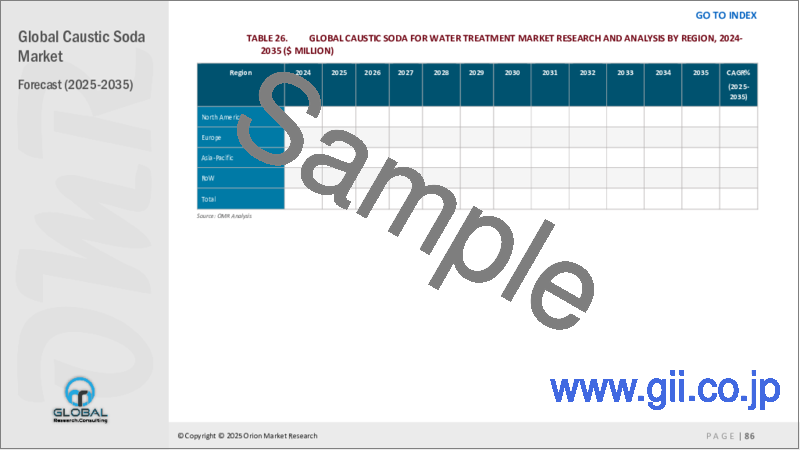|
|
市場調査レポート
商品コード
1610998
苛性ソーダの世界市場:2024~2031年Global Caustic Soda Market 2024-2031 |
||||||
カスタマイズ可能
|
|||||||
| 苛性ソーダの世界市場:2024~2031年 |
|
出版日: 2024年11月21日
発行: Orion Market Research
ページ情報: 英文 140 Pages
納期: 2~3営業日
|
- 全表示
- 概要
- 図表
- 目次
苛性ソーダ市場規模、シェア、動向分析レポート:生産プロセス別(膜セルプロセス、横隔膜セルプロセス、水銀セルプロセス)、形態別(固体、液体、フレーク)、用途別(パルプ・製紙、繊維、石鹸・洗剤、石油製品、アルミナ、化学生産、水処理、その他)予測期間(2024-2031年)
苛性ソーダ市場は、予測期間中(2024-2031年)に12.3%の大幅なCAGRで成長すると予測されています。苛性ソーダは、強アルカリ性であるため、産業用途での需要が増加していることが、業界成長の要因です。苛性ソーダは、石油製品、紙・パルプ、アルミナ、繊維製品、石鹸、洗剤の製造に不可欠で、化学処理、水処理、石油処理にも応用されています。保健省によると、生産された水酸化ナトリウムの約56.0%が産業界で使用され、そのうち25.0%は製紙産業で使用されています。その他の用途としては、燃料電池の製造、食品の硬化、缶詰のための野菜の皮除去、漂白剤、排水管洗浄剤、オーブン洗浄剤、石鹸、洗剤、製紙、紙のリサイクル、アルミニウム鉱石の加工、酸化物コーティング、綿織物の加工、酸洗、鎮痛剤、血栓予防のための抗凝固剤、コレステロール低下薬、水処理などがあります。
市場力学
工業生産における需要の増加、新興市場における消費の増加
苛性ソーダの主な消費分野は、繊維、アルミナ、無機物、パルプ・製紙、その他です。科学環境センター(CSE)によると、世界の苛性ソーダ生産量は年間約4,500万トンと推定されています。米国では、苛性ソーダの最大の使用者は有機化学工業30.0%、無機化学工業20.0%です。パルプ・製紙業界は、木材チップのパルプ化などに米国の苛性ソーダ生産量の約20.0%を使用しています。欧州では、化学産業が苛性ソーダの主要な消費者で、製紙産業がこれに続きます。その他のユーザーはアルミニウム産業です。
生産技術の革新
膜セルプロセスのような革新的な方法は、よりクリーンで効率的な代替案として登場し、環境への影響を低減し、生産プロセスを最適化しています。こうした進歩によりエネルギー効率が大幅に改善され、生産コストが低下しています。さらに、最新の生産ラインは製品の品質管理を向上させ、手作業の必要性を最小限に抑えています。これは最終的に、メーカーの効率と費用対効果の向上につながります。メーカーは、苛性ソーダ製造の効率をさらに高めるため、高度な最適化技術に目を向けています。これらの手法は、アルゴリズムや数学モデルを利用してプロセスデータを分析し、改善の機会を特定するものです。
市場セグメンテーション
- 市場は、製造プロセスに基づいて、膜セルプロセス、横横隔膜セルプロセス、水銀セルプロセスに区分されます。
- 形態により、市場は固体、液体、フレークに区分されます。
- 用途別では、市場はパルプ・製紙、繊維、石鹸・洗剤、石油製品、アルミナ、化学生産、水処理、その他(食品加工、医薬品)に区分されます。
固形セグメントが最大の市場シェアを占めると予測される
固形苛性ソーダの成長を支える主な要因は、パルプ・製紙、繊維、石鹸、洗剤、各種化学品など、数多くの製品の製造に応用されていることです。固形苛性ソーダは強力なアルカリ性化学物質で、空気中の水分を素早く吸収します。この製品の市場を定義する上で重要な役割を果たしています。この特性から、固形苛性ソーダは非常に簡単に水に溶け、溶けるときに熱を放出します。腐食性があるため、多くの工業プロセス、特に紙や繊維を生産するプロセスでは不可欠な成分であり、それぞれパルプ化および漂白の段階で使用されます。
パルプ・製紙部門が大きな市場シェアを占める
同分野の成長を支える要因としては、製紙用パルプに加工される木材のリグニン結合を破壊するための苛性ソーダ需要の増加が挙げられます。苛性ソーダは主に、パルプや紙の製造におけるパルプ、特にクラフトパルプの化学処理や調理に使用されます。亜硫酸塩、硫酸塩、ソーダを含むほとんどのパルプ漂白法には、苛性ソーダが使用されています。さらに、パルプは主に筆記用紙や印刷用紙の製造に使用されます。パルプと紙の生産は、苛性ソーダの主な用途です。苛性ソーダの世界市場は、パルプと紙の消費量の増加により発展すると予想されています。
地域別展望
世界の苛性ソーダ市場は、北米(米国、カナダ)、欧州(英国、イタリア、スペイン、ドイツ、フランス、その他欧州地域)、アジア太平洋(インド、中国、日本、韓国、その他アジア太平洋地域)、世界のその他の地域(中東とアフリカ、中南米)を含む地域別にさらに区分されます。
欧州における苛性ソーダ需要の増加
- この地域の成長は、パルプ・製紙、化学薬品・石鹸、洗剤など様々な用途からの苛性ソーダ需要の増加に起因しています。Euro Chlorによると、2023年6月の苛性ソーダ生産量は29万3,686トンに達しました。ドイツは、欧州大陸で最大の化学製造部門のひとつであり、欧州の化学産業が生み出す収益全体の27.0%を占めていると推定されます。支出、投資、輸出、化学品の販売において、ドイツの化学部門は重要です。地元企業による化学製品の輸出は、欧州のどの国よりも多いです。
アジア太平洋が大きな市場シェアを占める
アジア太平洋地域は、Aditya Birla Chemicals (India) Ltd. (Grasim Industries Ltd.)、Gujarat Alkalies and Chemicals Ltd. (GACL)、Hanwha Group、Shin-Etsu Chemical Co., Ltd.、Tata Chemicals Ltd.などの苛性ソーダを提供する企業が存在することから、重要なシェアを占めています。苛性ソーダ市場の成長は、繊維産業における精練、マーセライズ、染色といった繊維製造工程に不可欠な工程で苛性ソーダの需要が増加していることに起因しています。さらに、アルミナや無機物への苛性ソーダの採用が増加していることも、同地域の市場成長を後押ししています。インドアルカリ工業会によると、2023年3月31日時点の苛性ソーダの設備容量は556万MTPA(年間100万トン)。2022-23年の生産量は440万MT(100万トン)でした。2022-23年の稼働率は80.0%でした。輸出は34.0%増の458KT(キロ缶)でした。市場プレーヤーは、化学業界におけるプレゼンスをさらに強化するため、国内の苛性ソーダ生産量を増やしています。例えば、2022年4月、Hanwha Groupは苛性ソーダの増産を戦略的に決定しました。Hanwha Solutionsは現在、年間84万トンの苛性ソーダを生産しています。Hanwha Solutionsは苛性ソーダをさらに27万トン増産するため、2億8,200万米ドル(3,380億ウォン)を投資しました。
苛性ソーダ市場に参入している主要企業には、Dow Chemical Company、Formosa Plastics Corp.mOccidental Petroleum Corp. (OxyChem)、Olin Corp.、Westlake Chemical Corpなどがあります。市場競争力を維持するため、各社は提携やM&Aなどの戦略を駆使して事業拡大や製品開拓にますます力を入れています。
最近の動向
- 2023年12月、Asahi Kasei は欧州でクロールアルカリ電解セルのレンタルサービスの実証試験を導入しました。クロルアルカリ電解膜プロセスは、イオン交換膜を用いて食塩水を電気分解し、塩素、水素、苛性ソーダを製造します。環境負荷の高い水銀やアスベストをプロセス材料として使用する必要がなく、エネルギー効率も高いです。
目次
第1章 レポート概要
- 業界の現状分析と成長ポテンシャルの展望
- 調査方法とツール
- 市場内訳
- セグメント別
- 地域別
第2章 市場概要と洞察
- 調査範囲
- アナリストの洞察と現在の市場動向
- 主要市場動向
- 推奨事項
- 結論
第3章 競合情勢
- 主要企業分析
- Dow Chemical Company
- 概要
- 財務分析
- SWOT分析
- 最近の動向
- Formosa Plastics Corp.
- 概要
- 財務分析
- SWOT分析
- 最近の動向
- Occidental Petroleum Corp.(OxyChem)
- 概要
- 財務分析
- SWOT分析
- 最近の動向
- Olin Corp.
- 概要
- 財務分析
- SWOT分析
- 最近の動向
- Westlake Chemical Corp.
- 概要
- 財務分析
- SWOT分析
- 最近の動向
- 主要戦略分析
第4章 市場セグメンテーション
- 苛性ソーダの世界市場:製造プロセス別
- 膜セルプロセス
- 横隔膜セルプロセス
- 水銀セルプロセス
- 苛性ソーダの世界市場:形態別
- 固体
- 液体
- フレーク
- 苛性ソーダの世界市場:用途別
- パルプ・製紙
- 繊維製品
- 石鹸・洗剤
- 石油製品
- アルミナ
- 化学製造
- 水処理
- その他(食品加工、医薬品)
第5章 地域分析
- 北米
- 米国
- カナダ
- 欧州
- 英国
- ドイツ
- イタリア
- スペイン
- フランス
- その他欧州
- アジア太平洋
- 中国
- インド
- 日本
- 韓国
- その他アジア太平洋地域
- 世界のその他の地域
- ラテンアメリカ
- 中東・アフリカ
第6章 企業プロファイル
- Aditya Birla Chemicals(India)Ltd.(Grasim Industries Ltd.)
- AGC Group
- BASF SE
- Covestro AG
- Diversey, Inc.
- FMC Corp.
- Gujarat Alkalies and Chemicals Ltd.(GACL)
- Hanwha Solutions Corp.
- INEOS Group Ltd.
- JSC KAUSTIK
- Kemira Oyj
- LG Chem Ltd.
- Mitsui Chemicals, Inc.
- Nouryon Chemicals Holding B.V
- SABIC(Saudi Basic Industries Corp.)
- Shin-Etsu Chemical Co., Ltd.
- Sinochem Holdings
- Solvay S.A.
- Tata Chemicals Ltd.
- TOAGOSEI CO., LTD.
- Tosoh Corp.
LIST OF FIGURES
- 1. Global Caustic Soda Market Research And Analysis By Production Process, 2023 Vs 2031 (%)
- 2. Global Caustic Soda By Membrane Cell Process Market Share By Region, 2023 Vs 2031 (%)
- 3. Global Caustic Soda By Diaphragm Cell Process Market Share By Region, 2023 Vs 2031 (%)
- 4. Global Caustic Soda By Mercury Cell Process Market Share By Region, 2023 Vs 2031 (%)
- 5. Global Caustic Soda Market Research And Analysis By Form, 2023 Vs 2031 (%)
- 6. Global Solid Caustic Soda Market Share By Region, 2023 Vs 2031 (%)
- 7. Global Liquid Caustic Soda Market Share By Region, 2023 Vs 2031 (%)
- 8. Global Flake Caustic Soda Market Share By Region, 2023 Vs 2031 (%)
- 9. Global Caustic Soda Market Research And Analysis By Application, 2023 Vs 2031 (%)
- 10. Global Caustic Soda For Pulp And Paper Market Share By Region, 2023 Vs 2031 (%)
- 11. Global Caustic Soda For Textiles Market Share By Region, 2023 Vs 2031 (%)
- 12. Global Caustic Soda For Soaps And Detergents Market Share By Region, 2023 Vs 2031 (%)
- 13. Global Caustic Soda For Petroleum Products Market Share By Region, 2023 Vs 2031 (%)
- 14. Global Caustic Soda For Alumina Market Share By Region, 2023 Vs 2031 (%)
- 15. Global Caustic Soda For Chemical Production Market Share By Region, 2023 Vs 2031 (%)
- 16. Global Caustic Soda For Water Treatment Market Share By Region, 2023 Vs 2031 (%)
- 17. Global Caustic Soda For Other Application Market Share By Region, 2023 Vs 2031 (%)
- 18. Global Caustic Soda Market Share By Region, 2023 Vs 2031 (%)
- 19. US Caustic Soda Market Size, 2023-2031 ($ Million)
- 20. Canada Caustic Soda Market Size, 2023-2031 ($ Million)
- 21. UK Caustic Soda Market Size, 2023-2031 ($ Million)
- 22. France Caustic Soda Market Size, 2023-2031 ($ Million)
- 23. Germany Caustic Soda Market Size, 2023-2031 ($ Million)
- 24. Italy Caustic Soda Market Size, 2023-2031 ($ Million)
- 25. Spain Caustic Soda Market Size, 2023-2031 ($ Million)
- 26. Rest Of Europe Caustic Soda Market Size, 2023-2031 ($ Million)
- 27. India Caustic Soda Market Size, 2023-2031 ($ Million)
- 28. China Caustic Soda Market Size, 2023-2031 ($ Million)
- 29. Japan Caustic Soda Market Size, 2023-2031 ($ Million)
- 30. South Korea Caustic Soda Market Size, 2023-2031 ($ Million)
- 31. Rest Of Asia-Pacific Caustic Soda Market Size, 2023-2031 ($ Million)
- 32. Rest Of The World Caustic Soda Market Size, 2023-2031 ($ Million)
- 33. Latin America Caustic Soda Market Size, 2023-2031 ($ Million)
- 34. Middle East And Africa Caustic Soda Market Size, 2023-2031 ($ Million)
Caustic Soda Market Size, Share & Trends Analysis Report by Production Process (Membrane Cell Process, Diaphragm Cell Process, and Mercury Cell Process), by Form (Solid, Liquid, and Flake), and by Application (Pulp and Paper, Textiles, Soaps and Detergents, Petroleum Products, Alumina, Chemical Production, Water Treatment and Others) Forecast Period (2024-2031)
The caustic soda market is anticipated to grow at a significant CAGR of 12.3% during the forecast period (2024-2031). The industry growth is attributed to pivotal factors such as increasing demand for caustic soda in industrial applications owing to its strong alkaline nature. It is integral to the manufacture of petroleum products, pulp and paper, alumina, textiles, soaps, and detergents, along with its application in chemical processing, water treatment, and petroleum processing. According to the Department of Health, around 56.0% of sodium hydroxide produced is used by industry, with 25.0% of NaOH used in the paper industry. Some other uses include fuel cell production, curing food, removing skin from vegetables for canning, bleach, drain cleaner, oven cleaner, soaps, detergent, paper making, paper recycling, aluminum ore processing, oxide coating, processing cotton fabric, pickling, pain relievers, anticoagulants to prevent blood clots, cholesterol reducing medications, and water treatment.
Market Dynamics
Increasing Demand in Industrial Production, and Increasing Consumption in Emerging Markets
Major consuming sectors for caustic soda are textiles, alumina, inorganics, pulp & paper, and others. According to the Centre for Science and Environment (CSE), the world production of caustic soda is estimated to be around 45 million tons per year. In the US, the largest users of caustic soda are the organic chemical industry 30.0% and the inorganic chemical industry 20.0%. The pulp and paper industry uses about 20.0% of the US caustic soda production for pulping wood chips, and other processes. In Europe, the chemical industry is the major consumer of caustic soda followed by the paper industry. Other user is the aluminum industry.
Increasing Innovations in Production Technologies
Innovative methods such as the membrane cell process have emerged as cleaner and more efficient alternatives, reducing the environmental impact and optimizing the production process. These advancements have significantly improved energy efficiency, resulting in lower production costs. Additionally, modern production lines deliver better product quality control and have minimized the need for manual labor. This ultimately leads to enhanced efficiency and cost-effectiveness for manufacturers. The manufacturers are turning to advanced optimization techniques, to further enhance the efficiency of caustic soda production. These methods utilize algorithms and mathematical models to analyze process data and identify opportunities for improvement.
Market Segmentation
- Based on the production process, the market is segmented into the membrane cell process, diaphragm cell process, and mercury cell process.
- Based on the form, the market is segmented into solid, liquid, and flake.
- Based on the application, the market is segmented into pulp and paper, textiles, soaps and detergents, petroleum products, alumina, chemical production, water treatment, and others (food processing, pharmaceuticals).
Solid Segment is projected to hold the Largest Market Share
The primary factor supporting the growth of solid caustic soda is its application in the manufacturing of numerous products, including pulp and paper, textiles, soaps, detergents, and various chemicals. Solid caustic soda is a powerful alkaline chemical that rapidly absorbs moisture from the air. It plays a crucial role in defining the market for this product. As of this property, solid caustic soda dissolves in water very easily and releases heat as it dissolves. As for its corrosive qualities, it is an essential ingredient of many industrial processes, especially those that produce paper and textiles, where it is used in the pulping and bleaching stages, respectively.
Pulp and Paper Segment to Hold a Considerable Market Share
The factors supporting segment growth include increasing demand for caustic soda to break the lignin bonds of wood being processed into pulp for papermaking. Caustic soda is primarily used in the chemical processing or cooking of pulp, particularly kraft pulp, in the manufacturing of pulp and paper. Most pulp-bleaching methods, including sulfite, sulfate, and soda, involve the use of caustic soda. Moreover, pulp is mostly used in the creation of writing and printing paper. Production of pulp and paper is the primary usage for caustic soda. The global market for caustic soda is anticipated to develop as a result of rising pulp and paper consumption.
Regional Outlook
The global caustic soda market is further segmented based on geography including North America (the US, and Canada), Europe (the UK, Italy, Spain, Germany, France, and the Rest of Europe), Asia-Pacific (India, China, Japan, South Korea, and Rest of Asia-Pacific), and the Rest of the World (the Middle East & Africa, and Latin America).
Growing Demand for Caustic Sodas in Europe
- The regional growth is attributed to increasing demand for caustic soda from various applications such as pulp and paper, chemicals and soap, and detergents. According to the Euro Chlor, in June 2023, caustic soda production reached 293,686 tons. Germany is one of the biggest chemical manufacturing sectors in the continent, with an estimated 27.0% of the overall revenue generated by the European chemical industry. In terms of spending, investments, exports, and sales of chemicals, the German chemical sector is significant. More chemicals are still exported by local businesses than by any other country in Europe.
Asia-Pacific Holds Major Market Share
Asia-Pacific holds a significant share owing to the presence of caustic soda offering companies such as Aditya Birla Chemicals (India) Ltd. (Grasim Industries Ltd.), Gujarat Alkalies and Chemicals Ltd.(GACL)., Hanwha Group, Shin-Etsu Chemical Co., Ltd, Tata Chemicals Ltd. and others. The market growth is attributed to the increasing demand for caustic soda in the textile industry for processes such as scouring, mercerization, and dyeing, integral parts of the textile manufacturing process. Additionally, the increasing adoption of caustic soda in alumina and inorganics drives the growth of the market in the region. According to the Alkali Manufacturers Association of India, in 2023, the Installed Capacity of caustic soda as of 31 March 2023 was 5.56 million MTPA (Million Tons Per Annum). Production during the year 2022-23 was 4.4 million MT (Million Tons). The capacity utilization was 80.0% during 2022-23. The exports increased by 34.0%, to 458 KT (Kilo Tins) during the year. Market players are increasing their domestic caustic soda production volume, to further strengthen their presence in the chemicals industry. For instance, in April 2022, Hanwha Group made a strategic decision to increase its production of caustic soda. Hanwha Solutions is currently producing 840,000 tons of caustic soda per year. Hanwha Solutions invested $282.0 million (KRW 338.0 billion) to increase the production of caustic soda by an additional 270,000 tons.
The major companies serving the caustic soda market include Dow Chemical Company, Formosa Plastics Corp., Occidental Petroleum Corp. (OxyChem), Olin Corp., and Westlake Chemical Corp. among others. The market players are increasingly focusing on business expansion and product development by applying strategies such as collaborations, mergers and acquisitions to stay competitive in the market.
Recent Development
- In December 2023, Asahi Kasei introduced a demonstration trial on rental service for chlor-alkali electrolysis cells in Europe. The membrane process for chlor-alkali electrolysis produces chlorine, hydrogen, and caustic soda by electrolyzing brine using ion-exchange membranes. It eliminates the need to use environmentally hazardous mercury or asbestos as process materials and enables greater energy efficiency.
Table of Contents
1. Report Summary
- Current Industry Analysis and Growth Potential Outlook
- 1.1. Research Methods and Tools
- 1.2. Market Breakdown
- 1.2.1. By Segments
- 1.2.2. By Region
2. Market Overview and Insights
- 2.1. Scope of the Report
- 2.2. Analyst Insight & Current Market Trends
- 2.2.1. Key Market Trends
- 2.2.2. Recommendations
- 2.2.3. Conclusion
3. Competitive Landscape
- 3.1. Key Company Analysis
- 3.2. Dow Chemical Company
- 3.2.1. Overview
- 3.2.2. Financial Analysis
- 3.2.3. SWOT Analysis
- 3.2.4. Recent Developments
- 3.3. Formosa Plastics Corp.
- 3.3.1. Overview
- 3.3.2. Financial Analysis
- 3.3.3. SWOT Analysis
- 3.3.4. Recent Developments
- 3.4. Occidental Petroleum Corp. (OxyChem)
- 3.4.1. Overview
- 3.4.2. Financial Analysis
- 3.4.3. SWOT Analysis
- 3.4.4. Recent Developments
- 3.5. Olin Corp.
- 3.5.1. Overview
- 3.5.2. Financial Analysis
- 3.5.3. SWOT Analysis
- 3.5.4. Recent Developments
- 3.6. Westlake Chemical Corp.
- 3.6.1. Overview
- 3.6.2. Financial Analysis
- 3.6.3. SWOT Analysis
- 3.6.4. Recent Developments
- 3.7. Key Strategy Analysis
4. Market Segmentation
- 4.1. Global Caustic Soda Market by Production Process
- 4.1.1. Membrane Cell Process
- 4.1.2. Diaphragm Cell Process
- 4.1.3. Mercury Cell Process
- 4.2. Global Caustic Soda Market by Form
- 4.2.1. Solid
- 4.2.2. Liquid
- 4.2.3. Flake
- 4.3. Global Caustic Soda Market by Application
- 4.3.1. Pulp And Paper
- 4.3.2. Textiles
- 4.3.3. Soaps And Detergents
- 4.3.4. Petroleum Products
- 4.3.5. Alumina
- 4.3.6. Chemical Production
- 4.3.7. Water Treatment
- 4.3.8. Others (Food Processing, Pharmaceuticals)
5. Regional Analysis
- 5.1. North America
- 5.1.1. United States
- 5.1.2. Canada
- 5.2. Europe
- 5.2.1. UK
- 5.2.2. Germany
- 5.2.3. Italy
- 5.2.4. Spain
- 5.2.5. France
- 5.2.6. Rest of Europe
- 5.3. Asia-Pacific
- 5.3.1. China
- 5.3.2. India
- 5.3.3. Japan
- 5.3.4. South Korea
- 5.3.5. Rest of Asia-Pacific
- 5.4. Rest of the World
- 5.4.1. Latin America
- 5.4.2. Middle East and Africa
6. Company Profiles
- 6.1. Aditya Birla Chemicals (India) Ltd. (Grasim Industries Ltd.)
- 6.2. AGC Group
- 6.3. BASF SE
- 6.4. Covestro AG
- 6.5. Diversey, Inc.
- 6.6. FMC Corp.
- 6.7. Gujarat Alkalies and Chemicals Ltd. (GACL)
- 6.8. Hanwha Solutions Corp.
- 6.9. INEOS Group Ltd.
- 6.10. JSC KAUSTIK
- 6.11. Kemira Oyj
- 6.12. LG Chem Ltd.
- 6.13. Mitsui Chemicals, Inc.
- 6.14. Nouryon Chemicals Holding B.V
- 6.15. SABIC (Saudi Basic Industries Corp.)
- 6.16. Shin-Etsu Chemical Co., Ltd.
- 6.17. Sinochem Holdings
- 6.18. Solvay S.A.
- 6.19. Tata Chemicals Ltd.
- 6.20. TOAGOSEI CO., LTD.
- 6.21. Tosoh Corp.






